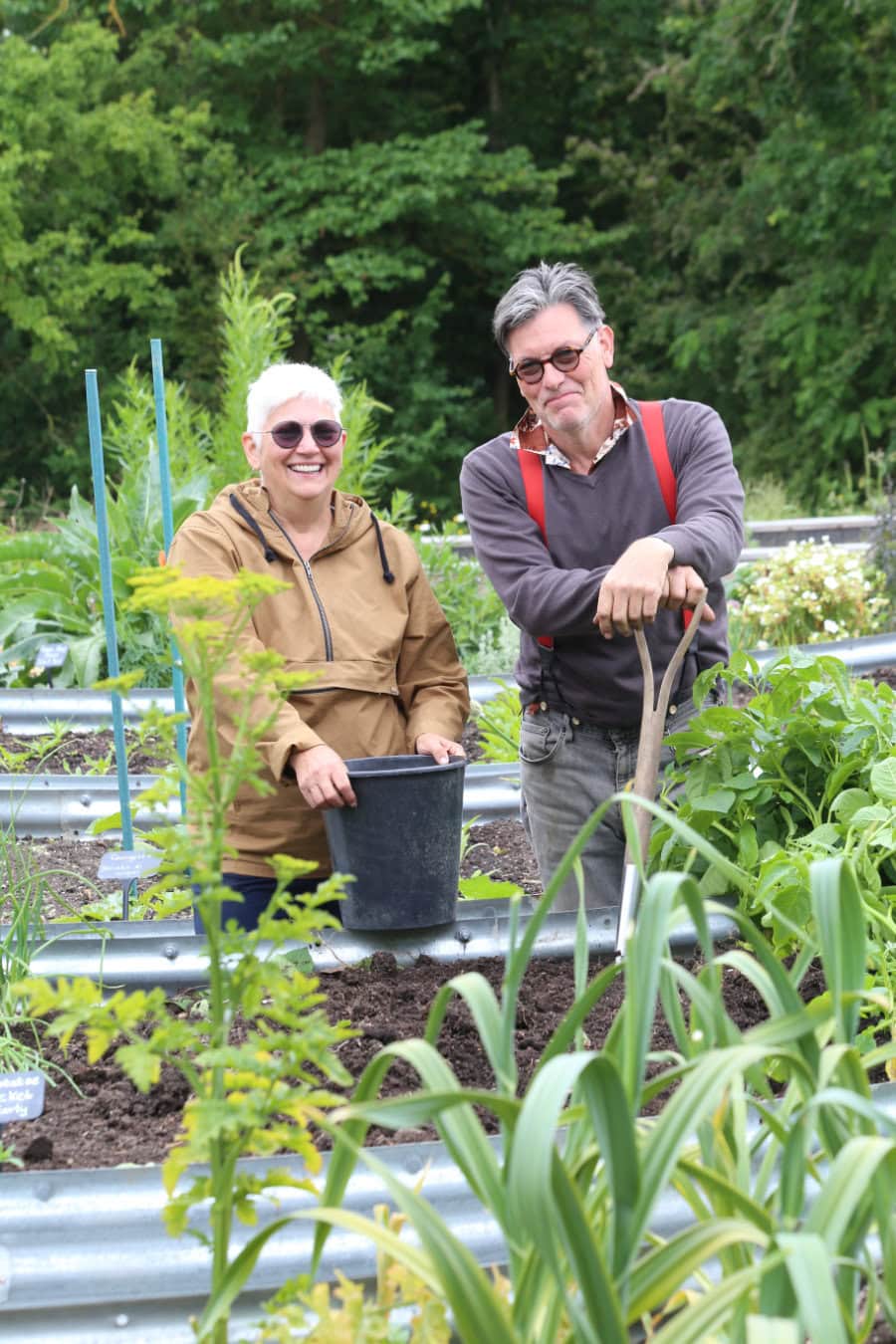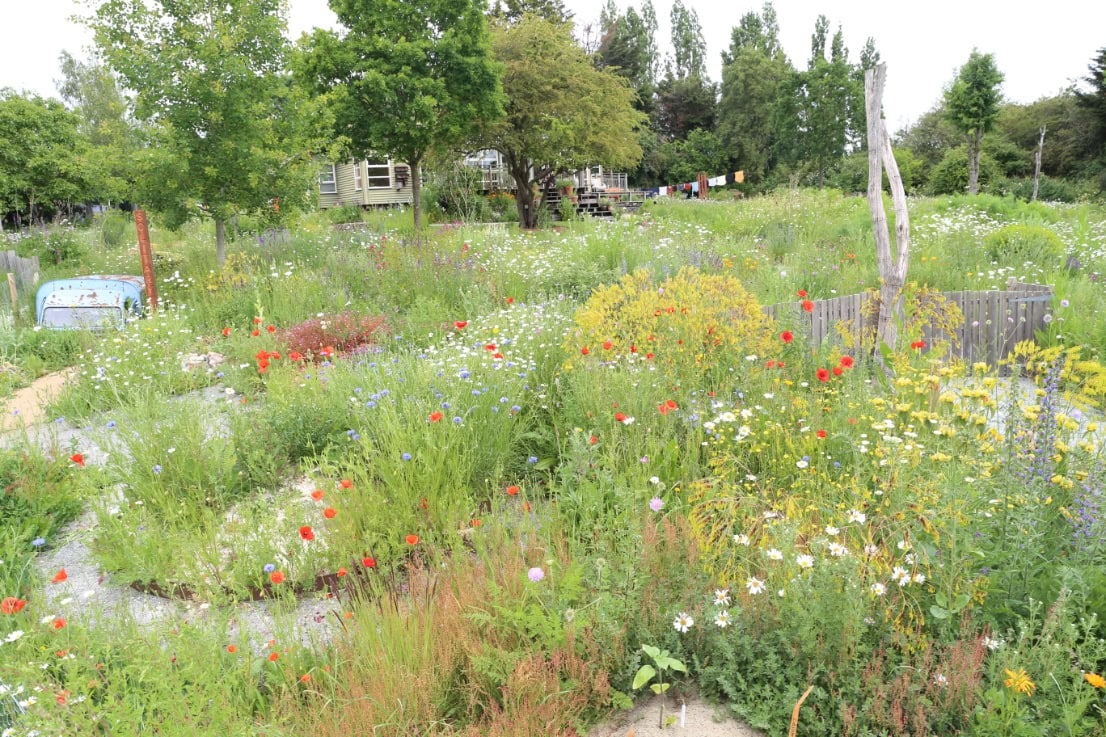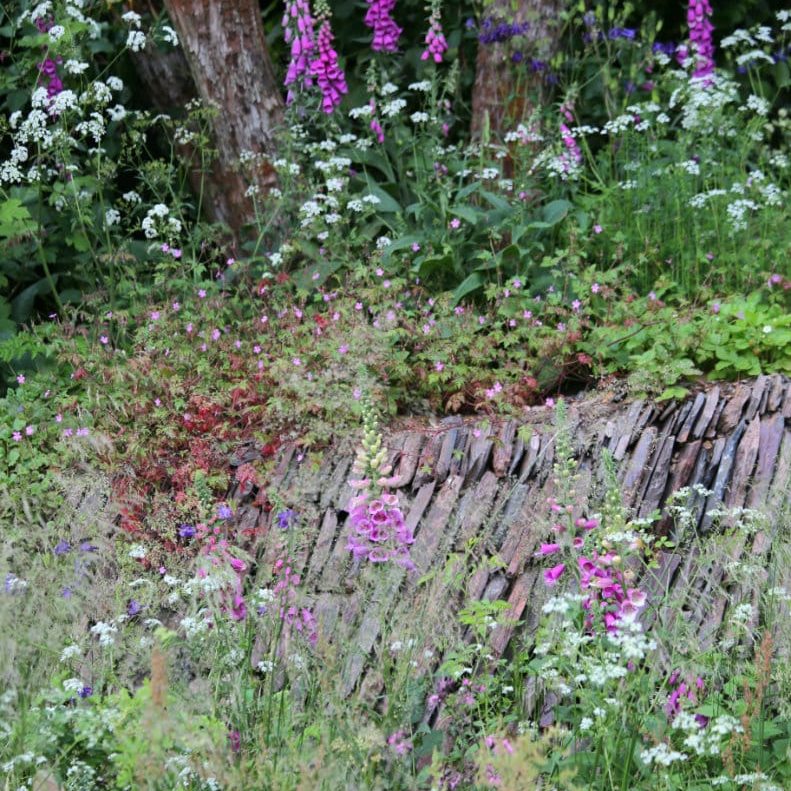What is Brownfield gardening?
There’s a new movement in gardening that offers low maintenance, high biodiversity and beautifully flower-rich landscapes. And if that’s not good enough, this style of garden usually comes at a greatly lower financial and environmental cost. So what is brownfield gardening? Either this is gardening an actual brownfield site, or taking inspiration and applying it in a normal garden setting. Brownfield sites could be huge derelict industrial lands or disused roads and railways. Or more commonly for homeowners, they could be the footings of a demolished building or an abandoned patio or driveway.

Why are brownfield sites special?
These sites, despite their industrial past, are some of the most biodiverse places in the UK. They are disproportionately represented in the list of SSSIs (Site of Special Scientific Interest). There are a few reasons for this. One big reason is the structural diversity, meaning a wide range of physical structures and soil types that can support a wide range of life. From rocky outcrops or decaying wood, to piles of sand where ground nesting bees live. Or muddy wetlands that form where the fine clay sediments from crushed concrete have settled. And the list goes on.
The other big reason is the low fertility of the soils and aggregates they tend to be covered in. The soils are often subsoils, as topsoil is usually removed and sold when land is turned to industry. Subsoils tend to be lower in nutrients. Aggregates such as sand, gravels, crushed brick and concrete, are also very low fertility, and free draining.
But why would low soil fertility make a place extra biodiverse? Because when there’s hardly any resources, no thuggish plant can get rich quick, grow tall and dominate at the expense of everything else. On pure crushed concrete, nettle, dock or bramble, can never get enough nutrients to grow big and lush. When there’s almost no nutrients in the soil, it evens the playing field and balances the competition between species, so even the smaller, daintier flowers get to grow next to the big boys.

The brownfield benefit for gardeners
The brownfield idea completely challenges the traditional garden approach of enriching the soil with manure and composts. For years gardeners have aimed for dark, rich soils, where vegetables grow huge and green, and roses leap for the sky with enormous blooms. The problem is that higher fertility soils are loved by the most problematic weeds, such as nettles, creeping thistles, couch grass, and docks. They germinate, grow and smother everything with great gusto on a fertile and moisture retentive soil.
And if weeds aren’t the problem, your own plants may be; on fertile soils, your most vigorous garden plants will romp away and smother all the smaller, slower growing more delicate species. This is why a diversely planted garden will tend to loose species over time. A few thuggish plants win out at the cost of everything else. Fertile soils are great for growing vegetables or prize dahlias, when people had more time for weeding, or staff to do it for them. However, what we ask of our gardens today is changing. People want flowers and beauty, but need a style of garden and pace of growth that is more easily manageable.

A more relaxed approach?
That’s not to say brownfield gardens are no or low maintenance. The style or finish that someone likes their garden maintained is very personal to them. But the natural suppression of weeds by the low fertility soil greatly reduces the weeding burden, and the more relaxed naturalistic aesthetic means there is no need for constant tidying and neatening. Saying that, there’s no reason these gardens need to be fully ‘naturalistic’, they could have formal layouts and structural elements like topiary and hedges too.
On pure stoney soils, plants grow slowly, staying shorter, strong and sturdy. This usually means no need for plant supports, and less need for lifting and dividing of plants. Slow growing smaller plants also makes cutting back herbaceous plants an easier task, with less green waste to lug around. Counterintuitively, these gardens can also be very drought tolerant, as plants get their roots down deep into the gravel or sand in search of more constant moisture , making them more resilient in hot dry weather.

A garden grown from seed
Unlike garden soil or most bought-in topsoils, most aggregates are almost completely free of weed seeds and root fragments. This means diverse perennial plantings can be established using seed mixes, without competition from weeds. Direct sown seed is by far one of the cheapest and lowest footprint ways of creating a garden, and achieves plant densities over 150 plants per square metre. Compare that to 9 per square metre which is the usual density for potted herbaceous perennials.
On a normal garden soil, there are generally huge numbers of weed seeds in the soil ‘seed bank’, including many fast growing annual weeds. This makes seeded plantings on normal soils difficult without great skill, but on clean low fertility aggregates the results are much more reliable. Perennials are generally directly sown in late summer or autumn, and allowed to settle in with the winter rains. If the following spring is dry, the area may need to be regularly irrigated to germinate and establish the plants.
The most knowledgeable, loveliest and most generous person in this scene is John Little, at his garden Hilldrop in Essex. He has experimented for about 20 years with a range of reclaimed and recycled aggregates, including various grades of crushed brick and concrete, pure sand, recycled sharp sand, crushed ceramics (toilets and bathtubs!), crushed glass, pure chalk, sand, and even coal! You can follow him on Instagram if you don’t mind a bit of fruity language, and he and his wife Fiona regularly open their gates to visitors on charity fundraising days.

Two things to consider when choosing your aggregates
Sourcing your aggregates: Ideally, you would be using aggregates that are already present on your site. For example, if an old driveway is being taken up this generates a lot of hardcore, gravel or tarmac chippings. Or if a building is knocked down, a mini-crusher can be used to turn this into crushed brick and concrete. Perhaps these aggregates are coming off a site nearby, or even from roadworks, it’s always worth asking.
You can also buy crushed aggregates from quarries, usually sold as a ‘waste product’, and these will be fully weed-free, but more expensive. But the better option environmentally is to source recycled aggregates from a local builders merchant or aggregate recycling company. They usually have a range of different grades and materials available. You’ll want to inspect it closely for contamination, such as soil or bits of sharp metal. With sand especially, if their piles and yard are covered in weeds, the sand will likely be full of weeds too. If you’re not sure, you can just get a small amount to test. See what comes up in it before investing in large quantities of potentially weed-infested material.
Fines: Aggregates containing even small amounts of fine rock dust will hold moisture for longer, meaning plants and weeds establish more easily. With few or no fines, weeds struggle to establish, but with regular irrigation you can establish seed mixes suited to very low fertility free draining conditions. The phrase ‘down to dust’ means it contains fines.

Playing with rubble; 3 things to decide
What’s beneath: If the soil beneath is fertile, if or when the plants’ roots reach it, the more thuggish plants will start to grow big and dominate at the expense of the more delicate ones. This means a loss in the diversity of the planting, with bigger plants more likely to flop and look messy. If the soil beneath is lowly fertile, such as low fertility subsoil, this will help keep the wisest range of species with the lowest maintenance. The planting will be lower, more open, delicate textured with smaller sturdier plants less prone to flopping. It is easy to get bogged down in the qualities of the different types of aggregates you may have access to. But, in the long term, John Little says “it’s what’s underneath that counts”. This is the factor that will really drive the long term behaviour of the planting.
Depth: The depth of the aggregate layer affects how many years the plants will take to reach the soil beneath. This is mostly relevant if the soil beneath is fertile. On a 10cm deep aggregate mulch, the plants will reach the fertility in their first year. But at 50cm depth, it could be 3 or 4 years down the line when all of a sudden the big boys start to romp away.
Mix it up: A diversity of environmental conditions will create a more diverse plant community. Very harsh areas will have lower, sparse and open planting, while more fertile areas will be taller and lusher. By using a range of different aggregates, at different depths and playing with surface mulches with and without fines, you can create long-lasting tapestry of different planting styles.

2 things to consider when it comes to plants
Pot-grown plants and seed: Potted plants, although more expensive, give you better creative control. Plants in 9cm or 2L pots, planted in autumn or early spring, is the usual approach. To suppress weeds, use a surface mulch of fine-free aggregates about 7-10cm deep, on top of soil or fine-containing aggregate beneath. The rootballs of plants planted through the surface mulch should be in contact with the more moisture-sensitive layer beneath. This is how the Sheffield Grey to Green scheme was planted. You may choose to plant some things, and seed others. ‘Stitch planting’ is the name of this approach. You may want to plant key architectural plants such as shrubs, trees and ornamental grasses. Sow seeds of the more ephemeral dainty herbaceous plants like californian poppies and wildflowers.
Seed mixes: Choose a seed mix appropriate for the conditions. Opt for a biodiverse green roof or brownfield perennial mix. They may include creeping thyme, sedums, and sea-thrift, as well as taller flowers like vipers bugloss and wild carrot. Purely native mixes will be more restricted in their flowering time, diversity and overall wow-factor. Pictorial Meadows’ Cottage Garden, Tuscan Hills or Persian Carpet perennial mixes are all well suited to the brownfield conditions. These embrace native and non-native species for a ‘designer meadow’ approach.

Know maintenance, not no maintenance
Maintenance: In brownfield gardens, there is still some maintenance to be done if you want to help it flourish and look its best for years to come. Weeding, although there’s less of it, is the main task. With any planting created by sowing seed directly on the ground, thinning and editing the plants is key. This will help make sure you have the nicest balance of a wide range of species. You will need to remove seedlings of unwanted grasses and woody weeds like brambles, buddleja, willow and birch, unless you want them. With herbaceous plants, cutting them back in winter raking off the debris helps the wisest range of species to survive. Accumulated leaf litter causes losses of the more sensitive species, either by smothering or providing habitat for slugs and snails. The cut stems are good habitat , so add them to dedicated habitat piles for wildlife.

Summing up
You may think this is all so alien and far-removed from what most people think makes a beautiful garden. However, this approach has somewhat dominated the show gardens at RHS Chelsea flower show for the past few years. Increasingly, people are choosing this approach as a way of creating low cost, low footprint, low maintenance gardens that maximise biodiversity and beauty. Don’t worry, you don’t need to bury your garden under a pile of rubble. Experiment with a small area, or use mounds and meandering ridges of aggregates to add topography and varying habitat conditions.
The key way to think of this approach, is that you use different types of aggregates to create the environmental conditions that will ultimately dictate the style of planting you want grow there. Design with rubble once, and then let the plants do the hard work from then on. Oh, and keep the sunny fertile areas for your vegetable beds! For more information on brownfield gardening, check out this fantastic report written by Sally Bower.
Not just a pile of rubble; with thoughtful design and use of structural elements that show intention, a brownfield garden can just be, a garden!
All photos taken by Owen Hayman, at Hilldrop in Essex, between 2021 and 2023.
Owen Hayman
Owen joined the Bestall & Co planting and aftercare team in spring 2019. He is an RHS qualified horticulturist, holding a full Level 3 Diploma in Horticulture, and recently came in the top 3 at the Northern Regional Final of The Young Horticulturist of the Year 2019. After first doing a foundation diploma in Fine Art, he went on to gain a degree and masters in Plant and Soil Science from the University of Sheffield in 2014. Owen worked as a researcher on various field research projects in Alaska, Panama and Borneo. When not away in the field, he became obsessed with visiting gardens and nurseries across the British Isles and the Netherlands, developing his own garden, and then taking on a walled allotment garden as a personal project. He realised his true passion was in horticulture, and so moved away from academia and into the world of specialist plant nurseries and professional gardening.
Owen is now studying the Wisley Diploma, but continues to write articles for us on a monthly basis, and we're delighted to maintain contact with such a passionate and knowledgable plantsman.




